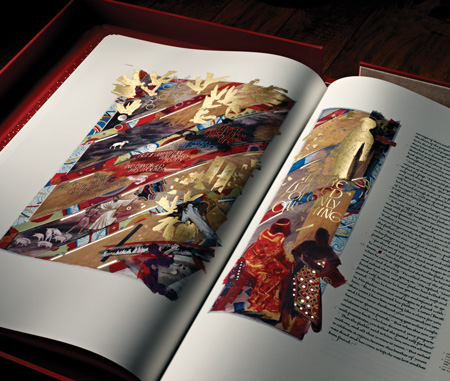
Luke Anthology, Donald Jackson with contributions from Aidan Hart and Sally Mae Joseph, © 2002 The Saint John’s Bible, Saint John’s University, Collegeville, Minnesota, USA. Used with permission. All rights reserved.
Thirty years ago, donald Jackson shared his lifelong dream with Eric Hollas, O.S.B.: to produce a handwritten, hand-illuminated, monumental Bible, the first of its kind commissioned in over 500 years.
As audacious as it sounded, Jackson and Hollas were two people most likely to make it happen. Jackson was the scribe to Her Majesty Queen Elizabeth II’s Crown Office; Hollas, a Benedictine monk, was then director of the Hill Museum & Manuscript Library (HMML) at Saint John’s University in Collegeville, Minnesota. Hollas brought the idea to his monastic community at Saint John’s Abbey; in 1998, they commissioned Jackson as the artistic director for The Saint John’s Bible, a project that took a dozen years to complete.
A team of scholars and theologians based at Saint John’s worked with a team of artists and scribes at Jackson’s scriptorium in Wales to produce the seven-volume, 1,100-page Bible. Measuring two feet by three feet when open, it includes over 160 illuminations and other artwork. A computer determined the placement of each line; all other aspects of production followed traditional methods: Vellum pages made from calfskin. Ink from nineteenth-century Chinese ink sticks. Vermillion, lapis lazuli, and other pigments mixed with egg yolk and water to make paint, and the artworks illuminated with gold, silver, and platinum leaf. Jackson developed a script for the project, and he and other calligraphers wrote with quills fashioned from bird feathers to inscribe the pages.
The finished volumes are dazzling in beauty and theological focus. The team of scholars chose the New Revised Standard Version translation to emphasize their ecumenical commitment, and many images convey biblical and Benedictine values of hospitality, transformation, and justice.
The Saint John’s Bible has been reproduced in two editions – the Apostles Edition of just 12 copies, now part of the collections of the Vatican Museum of Art, the Library of Congress, Washington National Cathedral, Lambeth Palace Library, St. Patrick’s Cathedral, and private collections; and the 299-copy Heritage Edition, acquired by universities, churches, and hospitals in North America, Europe, Asia, and Australia.
But to see the original manuscript of The Saint John’s Bible, one must make the pilgrimage to Collegeville. Twenty-eight original folios showcasing work from all seven volumes are on display at The Saint John’s Bible Gallery at HMML, as are tools, materials, and sketches used in the Bible’s creation.
Altogether, the exhibition speaks to the painstaking process and stunning final product that fulfills the project’s vision of glorifying God’s Word, reviving tradition, discovering history, fostering the arts, and giving voice.